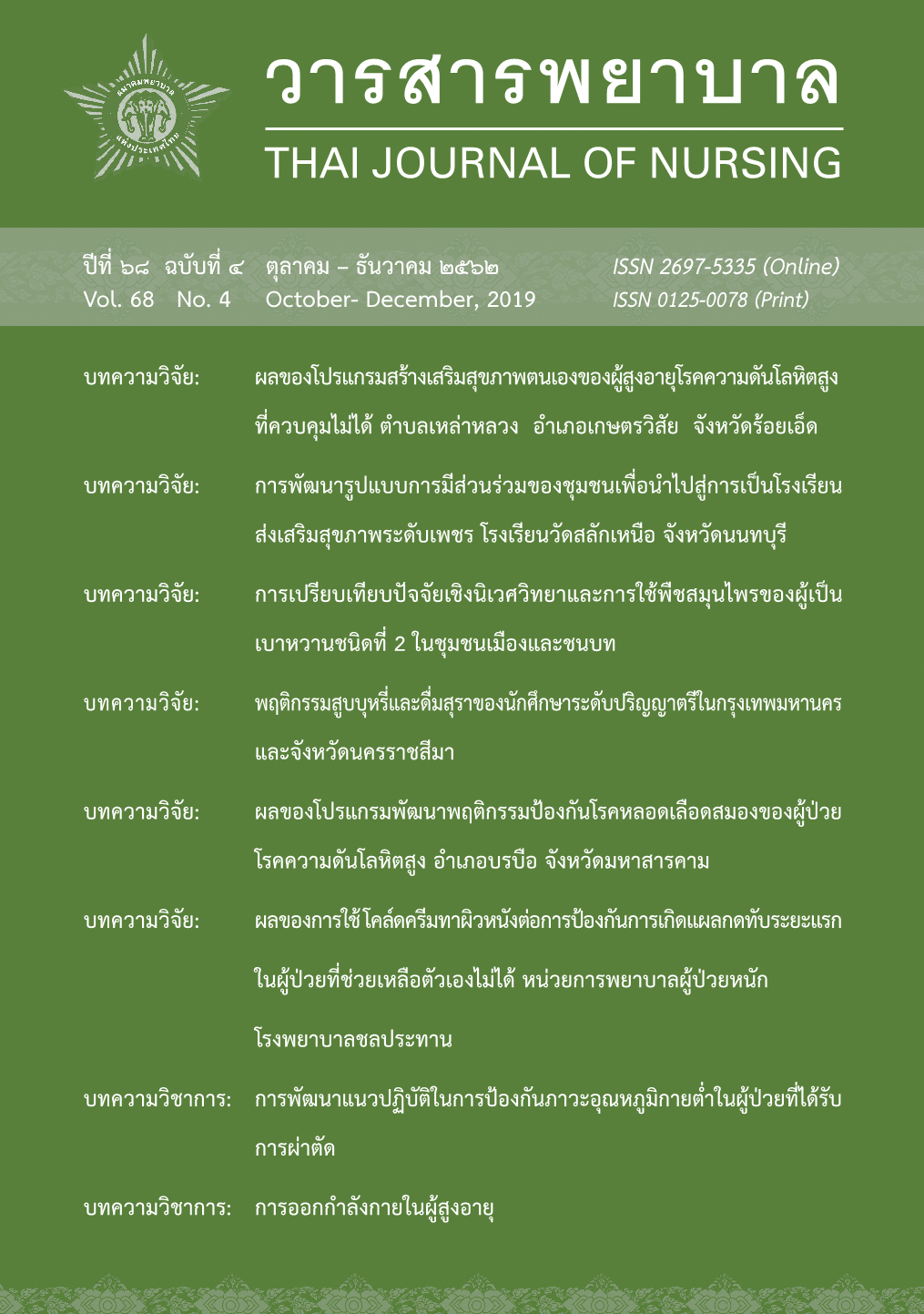Exercise for the elderly
Main Article Content
Abstract
Exercise has much benefits for the elderly that it should be a part of everyday life. There are four types of exercises for the elderly including endurance, balance, strengthening, and flexibility. Endurance or aerobic exercise activities increase breathing and heart rate, brisk walking is the best advantage among aerobic exercise activities for older adults. Balance exercise help to improve mobility and can prevent falls. Strengthening or resistance exercise make the muscles stronger. Lifting weights can build up strength. Flexibility or stretching exercise stretch your muscles and help your body do daily activity and improve range of motion. Dance, yoga, and stretching are the a typical type of muscle group exercise.
Article Details
References
ปิยะภัทร เดชพระธรรม. (2558). การออกกำลังกายในผู้สูงอายุ. ใน ประเสริฐ อัสสันตชัย. (บก.).
ปัญหาสุขภาพที่พบบ่อยในผู้สูงอายุและการป้องกัน (หน้า 399 – 422). กรุงเทพมหานคร: ยูเนียนครีเอชั่น.
วิไล คุปต์นิรัติกุล. (2561). การออกกำลังกายในผู้สูงอายุ. สืบค้นเมื่อ 15 ธันวาคม 2561, จาก https://www.
rehabmed.or.th/ main/wp. Content/ update// 2014/ 03/ exercise 1. Doc
เสก อักษรานุเคราะห์. (2553). การออกกำลังกายในผู้สูงอายุ. ใน อรรณณพ ใจสำราญ, สมพล สงวนรังศิริกุล,
อดิศร ภัทราดูลย์, สุกัญญา ชัยกิตติศิลป และ อารีรัตน์ สุพุทธิธาดา. (บก.). สังคมสูงวัยเปี่ยมสุขด้วยวิถีสุขภาพและสิ่ง
แวดล้อม (หน้า 37 - 68). กรุงเทพมหานคร: คอนเซ็พท์ เมดิคัส.
American College of Sports Medicine. (2011). Position stand: Quantity and quality of exercise
for developing and maintaining cardio – respiratory, musculoskeletal and neuromotor fitness
in apparently healthy adults: Guidance for prescribing exercise. Medicine and Science in
Sports and Exercise, 43(7), 1334 – 1359.
Carter, N. D., Kunnus, P., & Khan, K. M. (2001). Exercise in the prevention of falls in older people:
A systematic literature review examining the rational and the evidence. Sports Medicine, 31(6),
– 438.
Frontera, W. R., & Bigard, X. (2002). The benefits of strength training in the elderly. Science and
Sports, 17, 109 – 116.
Haber, D. (2013). Health promotion and aging practical: Applications for health professionals(6th.ed.).
New York, NY: Springer Publishing.
Miller, C. (2009). Nursing for wellness in older adults (5th.ed.). Philadelphia: Lippincott Williams
& Wilkins.
Nay, R., Garratt, S., & Fetherstonhaugh, D. (2014). Older people: Issues and innovations in care.
New York: Elsevier.
Saxon, S. V., Etten, M. J., & Perkins, E. A. (2015). Physical change and aging: A guide for helping
professions (6th.ed.). New York, NY: Springer Publishing.
Wolf, S. L., Barnhart , H. X., Kutner, N. G., McNeely, E., Coogler, C., & Xu, T. (1996 ). Reducing frailty
and falls in older persons: An investigation of Tai Chi and computerized balance training. Journal
of the American Geriatric Society, 44, 489 – 497.


